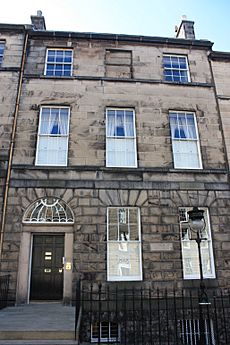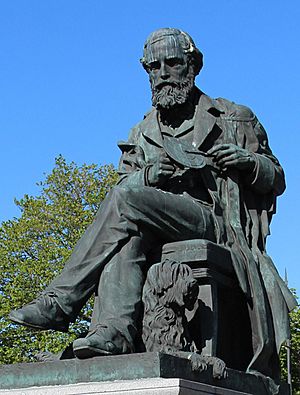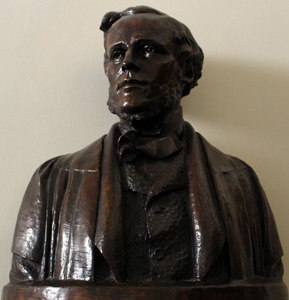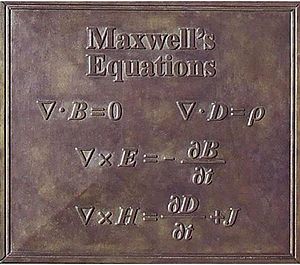James Clerk Maxwell Foundation facts for kids
The James Clerk Maxwell Foundation is a special group in Scotland that helps people learn about science and math. It was started in 1977 to honor James Clerk Maxwell (1831–1879). He was one of the most important scientists ever! The Foundation wants more people to understand and trust science. It also takes care of a small museum in the house where Maxwell was born.
What the Foundation Does

The James Clerk Maxwell Foundation wants everyone to know about the amazing scientific discoveries Maxwell made. They show how important his ideas still are today. The Foundation explains his many clever inventions and shares the story of his family at his birthplace.
They also give out awards and help with math challenges. This encourages young students to become great mathematicians, scientists, and engineers. The goal is to inspire future leaders in science.
How the Foundation Started
The James Clerk Maxwell Foundation was created in 1977. It was started by a man named Sydney Ross. He was a professor of chemistry in New York, USA. Sydney Ross was born in Scotland. He used money he inherited from his father's whisky business to help set up the Foundation.
In 1993, the Foundation bought the house at 14 India Street in Edinburgh. This is the house where Maxwell was born.
Since 1993, the house has been fixed up to look like it did a long time ago. A small museum was also created inside. It shows Maxwell's family, his life, and his scientific breakthroughs. Thanks to this work, Maxwell is now known as the most famous scientist between the times of Isaac Newton and Albert Einstein.
Maxwell's Birthplace House
James Clerk Maxwell was born at 14 India Street on June 13, 1831. This house has four floors. Each floor has about three or four rooms. The Foundation rents out the basement and top floor. They keep the ground and first floors as a museum. You can visit the museum by making an appointment ahead of time.
Maxwell's father, John Clerk Maxwell of Middlebie, owned land in Galloway. He spent his time between Galloway and his house in Edinburgh. In 1830, John Clerk Maxwell started building a new house on his farm. He later named it Glenlair House. When James was two years old, his family moved to Glenlair permanently.
Maxwell's mother passed away when he was only eight years old. Two years later, he came back to Edinburgh to go to school. He studied at the University of Edinburgh and the University of Cambridge. Later, he became a professor at different universities. These included Marischal College in Aberdeen, King's College London, and the University of Cambridge. While in Aberdeen, Maxwell married Katherine Dewar.
The Museum Displays
The main entrance hall has a copy of a statue of Maxwell. The original is in Aberdeen. There is also a special plaque from the Institute of Electrical and Electronics Engineers (IEEE). This plaque celebrates Maxwell's important work on how electricity and magnetism are connected. The museum also shows a timeline of Maxwell's life. It explains how his ideas are still used today in things like mobile phones, GPS, and Radar.
The Exhibition Room
This room used to be the dining room. It now has several family pictures. There is a copy of a painting of James Clerk Maxwell. There are also portraits of his father, John Clerk Maxwell. You can see early drawings of Maxwell's uncles, Robert and John Cay, his aunt Jane, and his mother Frances Cay. These were drawn by his grandmother, Elizabeth Cay. There is also a painting of Elizabeth's husband, Robert Hodshon Cay. Finally, there is a portrait of Maxwell's good friend, Peter Guthrie Tait. He was a professor at Edinburgh University.
One of Maxwell's biggest inventions was the first full-color projected image. This was amazing because at that time, people only had black-and-white photos. He showed this famous color image in 1861 in London. He took three black-and-white photos of a 'tartan ribbon'. He used red, green, and blue filters for each photo. Then, he used three special projectors to shine these images onto a screen. Each image was projected through the same red, green, and blue filters. This created the first color image! This idea of mixing red, green, and blue to make colors is still used today. It's how printing, digital cameras, televisions, and computers show colors.
The museum also has a copy of Maxwell's "color box." He used this box to study and mix light colors. This helped him understand how we see colors. It also built on the work of Isaac Newton.
Maxwell's most famous work was creating the equations for electromagnetism. These are called Maxwell’s equations. In 1865, he wrote a paper that described electromagnetism using 20 equations. Later, in 1873, he put them all in a book. Other scientists, like Oliver Heaviside, later made them into the simpler form we use today.
Maxwell's theory was the first "grand unification theory" in science. It showed that electric and magnetic fields are actually part of the same thing. This is called the electromagnetic field. For example, if you stand still, you might only feel an electric field. But if you move, you might also feel a magnetic field. It's the same field, just seen in different ways.
In 1905, Albert Einstein showed that Maxwell's equations were very special. They worked perfectly with his new idea of "relativity." This helped Einstein prove his theory that how we see things depends on how we are moving.
The museum also shows a copy of part of Maxwell's machine. He used it to measure the speed of electromagnetic waves. Maxwell showed that this speed was the same as the speed of light. Scientists like Fizeau and Ole Roemer had already measured the speed of light. In his 1865 paper, Maxwell wrote something very famous. He said that light is an electromagnetic wave! The famous physicist Richard Feynman later called this the most amazing discovery of the 1800s.
A display cabinet shows some pages of Maxwell's work on oval curves. These pages are on loan from The Edinburgh Academy. Maxwell made the work of René Descartes simpler. He presented this work to the Royal Society of Edinburgh. He was only 14 years old at the time! Maxwell's second science paper was written when he was 17. The cabinet also shows three of Maxwell's medals. These include the 1860 Rumford Medal for his work on color.
The Library
This room used to be Maxwell's father's office. Now, it has displays about Maxwell's other big scientific achievements. These include his work on machine speed control, how gases behave, and discovering the shape of Saturn's rings. He also helped define the Ohm, which is a unit of electrical resistance. Another achievement was his work on designing strong structures like roofs and bridges. The library also has books about Maxwell, Isaac Newton, Lord Kelvin, and Michael Faraday.
The Staircase
The pictures on the staircase walls are from Sir John Herschel's collection. They show the history of science and math. They start with Copernicus and go up to Maxwell's time. They include pictures of his friends and colleagues like Michael Faraday and Lord Kelvin.
The Upper Exhibition Room
This room is next to the original drawing room. It is the exact room where James Clerk Maxwell was born in 1831. It has things about the Clerk family, Maxwell's childhood, and his early career. You can even see some of his poems. There is also a copy of a painting of James and his mother. The main display here shows beautiful watercolours by Maxwell's cousin, Jemima Wedderburn.
The Conference Room
The Conference Room used to be the Drawing Room. It is now used for meetings and events. It has a Latin saying that means: "From this house of his birth, his name is now known everywhere – across the whole world and even to the stars." The biggest painting in this room is of Professor Peter Higgs. He is a Nobel Prize winner and a supporter of the Foundation. His research led to the search for the Higgs boson at the Large Hadron Collider.






